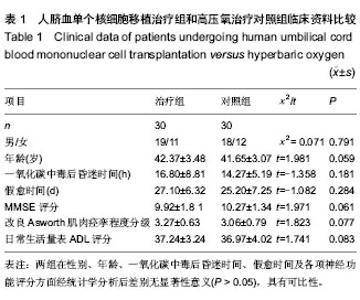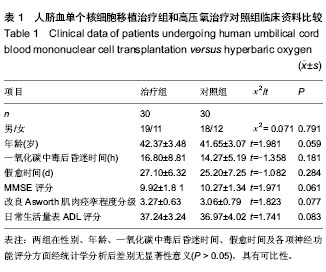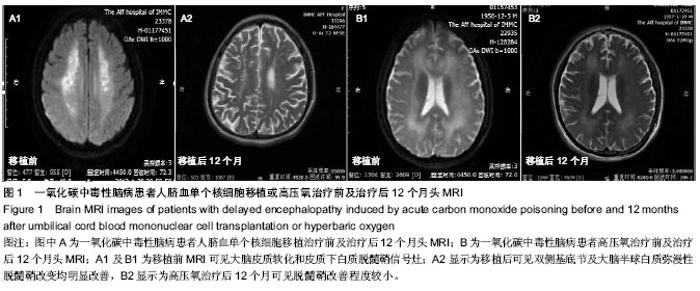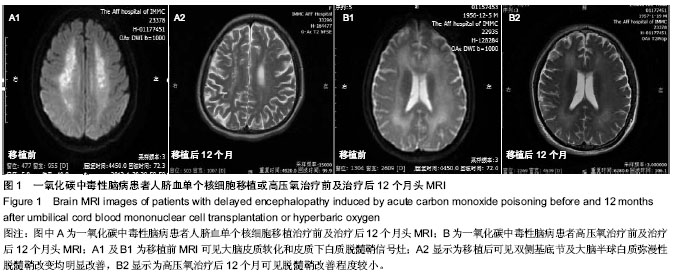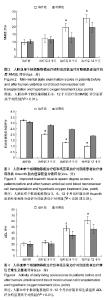| [1] 黄韶清,周玉淑,刘仁树.现代急性中毒诊断治疗学[M].北京:人民军医出版社,2002;190.
[2] Piantadosi CA.Carbon monoxide poisoning.Undersea and hyperbaric Medicine. Spring.2004;31(1):167-177.
[3] Hu H, PX, Wan Y, Zhang Q,et al.Factors affecting the prognosis of patients with delayed encephalopathy after acute carbon monoxide poisoning.Am J Emerg Med. 2011; 29(3): 261-264.
[4] Rogers I,Casper RF.Umbilical cord blood s tem cells . Best Pract ResClin Obs tet Gynaecol.2004;18(6):893-908.
[5] Goodwin HS,Bicknese AR,Chien SH,et al.Multilineage differentiation activity by cell sisolated from umbilical cord blood;expression of bone,fat,and neural markers.Biol Blood Marrow Transplant.2001;7:581-588.
[6] Duan X,Kang E,Liu CY,et al.DeveIopment of neuraI stem ceII in the adult bran. Curr Opin Neurobiol.2008;18(1):108-115.
[7] Jurga M,Markiewicz I,Sarnow ska A, et al Neurogenic potential of human umbilical cord blood:neura-l like stem cells depend on previous long- term culture conditions.Neuro Sci Res.2006;83(4):627.
[8] 刘斌,刘波,段答,等.脐血单核细胞治疗脊髓损伤的临床观察[J].湖南师范大学学报:医学版,2012,9(1):62-65.
[9] 叶任高.内科学[M].5版.北京:人民卫生出版社,2001: 965.
[10] 中华人民共和国国务院.医疗机构管理条例.1994-09-01.
[11] Raub JA, Benign us VA. Carb on m on ox ide and the nervous system. Neu rosci Biobeh av Rev.2002;26(8):925- 940.
[12] Uemura K, H shino S, Uchida K, et al. Hypothermia attenuates del ayed cortical cell death and ROS generation following CO in halation. Toxicology Lett ers.2003;145:101-106.
[13] Raub JA, Benign us VA. Carbon monoxide and the nervous system. Neu rosci Biobeh av Rev.2002;26( 8) : 925- 940.
[14] Uemura K, H shino S, Uchida K, et al. Hypothermia attenuates delayed cortical cell death and ROS generation following CO in halation. Toxicology Lett ers.2003;145: 101- 106.
[15] Hara S, Mukai T, Kurosaki K, et al . Modification of the striatal dopaminergic neuron system by carbon monoxide exposure in f ree- moving rat s, as determined by in vivo brain microdialysis. Arch T oxi col.2002;76(10): 596-605.
[16] Lam SP, Fong SY, Kwok A, et al.Delayed neuropsychiatric impairment after carbon monoxide poisoning from burning charcoal. Hong Kong Med J.2004;10:428-431.
[17] Yamazaki Y, Yamada A. Delayed Encephalopathy after Carbon Monoxide Intoxicati on. Internal Medicine.2008;47: 1071-1072
[18] Thorn SR, Fisher D,Zhang J,et al.Neuronal nitric oxide synhase and N- methyl- D- aspartate neurons in experimental carbon monoxide poisoning. Toxicol APPl Pharmaal.2004;194: 280.
[19] 曾员英,胡慧军,潘晓雯.急性一氧化碳中毒迟发性脑病免疫机制的研究进展[J].北京医学, 2008,30(1):43- 45.
[20] Cheinkestel CD, Bailey M, Myles PS, et al. Hyperbaricornorm baric for acute carbon monoxide poisoning: Arandomized controlled clinical trial. Med J Aust.1999;170(5):203-210.
[21] O'Brien TA, Tiedemann K, Vowels MR. No longer a biological waste product: umbilical cord blood.Med J Aust.2006;184(8): 407.
[22] Song S, nchez-Ramos J. eparation of neural progenitors from bone marrow and umbilical cord blood. thods Mol Biol. 2008;438:123
[23] 吴祖泽,贺福初,裴雪涛.造血调控[M].上海:上海医科大学出版社,2000:245.
[24] 张巧玲,覃莉珍,解继胜,等.脐带血间充质干细胞研究进展及应用前景[J].右江民族医学院学报,2005,27(1):101-103.
[25] Tse WT, Pendleton JD,Beyer WM, et al. Suppression of T-cell proliferation by human marrow stromal cells: implications in transplantation.Transplantation. 2003;75:389.
[26] Jurga M, Markiewicz I, Sarnowska A, et al. Neurogenic potential of human umbilical cord blood: neural like stem cells depend on previous long-term culture conditions.Neuro Sci Res.2006;83:627
[27] 姚星宇,杨丽敏,张国华.人脐血单个核细胞中的神经样细胞研[J].临床神经病学杂志,2013,26(1):46-48.
[28] 向静,王昌铭,王景周.脐血单个核细胞体外定向分化为神经移植细胞及其致瘤性的实验研究[J].中国医药导报, 2007,4(26): 14-16.
[29] Qu T,Brannen CL,Kim HM,et al.Human neural stem cells improve cognitive function of aged brain. Neuroreport. 2001; 12(6):1127-1132.
[30] Vendrame M,Cassady J,Newcomb J,et al.Infusion of human umbilical cord blood cells in a rat model of stroke dose-dependently rescues behavioral deficits and reduces infarct volume.Stroke. 2004;35(10):2390-2395.
[31] Blann A,Kumar P,Krupinski J,et al.Soluble intercelluar adhesion molecule-1,E-selectin,vascular cell adhesion molecule-1 and von Willebrand factor in stroke. Blood Coagul Fibrinolysis. 1999;10(5):277-284.
[32] Kim JS.Cytokines and adhesion molecules in stroke and related diseases.J Neurol Sci.1996;137(2):69-78.
[33] Jeong JA, Gang EJ, Hong SH, et al. Rapid neural differentiation of human cord blood-derived mesenchymal stem cells. Neuroreport. 2004,15(11):1731-1734.
[34] Tao YX, Xu HW, Zheng QY, et al. Noggin induces human bone marrow –derived mesenchymal stem cells to differentiate into neural and photoreceptor cells.Indian J Exp Biol.2010;48(5):444-452.
[35] 卢旺盛,田增民,赵全军,等.立体定向神经干细胞移植治疗脑出血后遗症疗效分析[J].中华神经外科疾病杂志,2008,21(6):58-62.
[36] Bieback K, Kern S, Kluter H, et al. Critical parameters for the isolation of mesenchymal stem cells from umbilical cord blood Stem Cells. Curr Stem Cell Res.2004; 22(4):625-634.
[37] Tang CH, Yang RS, Huang TH, et al. Enhancement of fibronectin fibrillogenesis and bone formation by basic fibroblast growth factor via protein kinase C-dependent pathway in rat osteoblasts. Mol Pharmacol.2004;66(3):440-449.
[38] Kanemura Y. Development of cell-processing systems for human stem cells (neural stem cells, mesenchymal stem cells and iPS cells) for regenerative medicine.Keio J Med.2010; 59(2):35-45.
[39] Yu MJ, Xiao ZF, Shen L, et al.Mid-trimester fetal blood-derived adherent cells share characteristics similar to mensenchymal stem cells but full term umbilical cord blood does not. British J Haemetology.2007;(124):666-675.
[40] 邢红霞,殷闯,王玉梅,等.骨髓间充质干细胞移植急性一氧化碳中毒迟发性脑病大鼠星形胶质细胞及髓鞘的变化[J].中国组织工程研究,2011,15 (6):1035-1039
[41] Le Blanc K,Tammik L,Sundberg B, et al. Mesenchymal stem cells inhibit and stimulate mixed lymphocyte cultures and mitogenic responses independently of the major histocompatibility comp lex.Scand J Immunol.2003;57 (1) : 11220.
[42] 樊建岭,黄河.骨髓间充质干细胞的免疫学特性及其在造血干细胞移植中的应用[J].国际输血及血液学杂志,2006,29(1) : 47249. |
